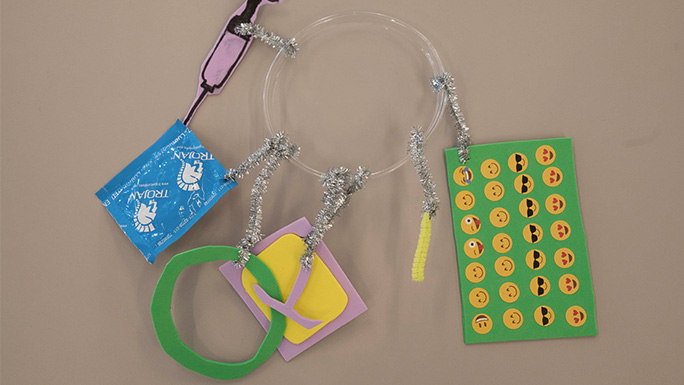University of Chicago, South Side students design and develop new contraceptive counseling tool for young people
University of Chicago, South Side students design and develop new ... UChicago Medicine


A New Contraceptive Educational Tool Supports Adolescent Health Care Decision-Making
A new contraceptive educational tool designed with more than two dozen South Side teenagers and developed by the University of Chicago will help teach young people about various forms of birth control to support adolescent health care decision-making.
Hello Options: A Portable Decision Aid
Hello Options is a portable, all-in-one decision aid featuring 3D replicas of birth control methods that doctors, nurses, and counselors can share with patients during clinic visits. It includes real-size models of birth control pill packets, long-term contraception methods, and various condoms. The tool, which allows patients to see, touch, and explore the range of available contraceptive options that are attached to a central ring, became available this month.
Co-Designed by UChicago and South Side Adolescents
The tool was co-designed by UChicago’s Center for Interdisciplinary Inquiry and Innovation in Sexual and Reproductive Health (Ci3) and 31 South Side adolescents and young adults between the ages of 14 and 20 who worked with the center on the project.
Each contraception method in Hello Options is arranged around a central ring and can be removed or moved around so providers can easily integrate the tool into their counseling. It has been clinically tested by contraceptive care providers and adolescents.
“We believe Hello Options offers young people the opportunity to explore all their contraceptive options, supporting greater agency in their own reproductive healthcare journeys.”
“Hello Options manifests what we heard from young people about what they want and need from their contraceptive counseling experience: an interactive way to connect their curiosity about the full range of birth control methods—how they look, feel, and work—to the expertise of their healthcare provider or sex educator,” said Amanda Geppert, PhD, MPH, Director of Design at Ci3. “Hello Options shows us how quality care can be defined by young people in the earliest phases of the design process and how tools to support that care can be realized by a commitment to the design requirements they deemed essential throughout the development process.”
Supporting Patient-Centered Counseling
Adolescents and young adults hold a wide range of contraceptive values and preferences, which means provider counseling must be individualized and responsive to patient priorities. Decision aids can be helpful in supporting this type of patient-centered counseling. Research suggests that young people prefer contraceptive decision aids that include realistic imagery, clear explanations of side effects, and details on method use. Moreover, effective decision aids can spark conversations between young people and providers, inviting adolescents to participate in health care decision-making at an important developmental age.
A Human-Centered Design Project
Hello Options was developed as part of a comprehensive human-centered design project at Ci3 to improve the experience of adolescent sexual and reproductive healthcare. The adolescents who co-designed the tool interviewed public health experts, toured a clinical space, led simulated patient visits, and drew on their own lived experiences to identify real-world opportunities. Ultimately, they came up with a Hello Options prototype. Ci3 then worked with industrial designers to develop the final product, with feedback from providers and young people along the way.
Evaluation and Feedback
As part of a study to test the Hello Options tool in a real-world clinic, Ci3 researchers evaluated the usability, feasibility, and acceptability with ten contraceptive care providers and 40 adolescent and young adult patients at two Chicago clinics. Patients reported that it helped them better understand how contraceptive methods work in their body and make more informed decisions. Providers thought the tool facilitated conversations, helped dispel myths, and eased patient anxieties.

“We are excited to announce the availability of Hello Options and related resources, which are the culmination of years of meticulous design and development in collaboration with young people and providers,” said Lee Hasselbacher, Ci3 Faculty Director. “This achievement reflects Ci3’s mission to create resources with and for young people. We believe Hello Options offers young people the opportunity to explore all their contraceptive options, supporting greater agency in their own reproductive healthcare journeys.”
Additional Resources
Support materials for Hello Options also include tear sheets with information about all the tool’s contraceptive methods for providers to share and discuss with patients. The tear sheets recently won the Core77 Design for Social Impact Award.
Continuing Efforts for Adolescent Sexual and Reproductive Healthcare
Hello Options is the latest development from Ci3’s programs with South Side youth. The center also recently launched Let’s Chat, a web application resource featuring questions related to seven essential topics of adolescent sexual and reproductive healthcare, such as, “Which birth control may be right for me or my partner(s)?” and “How much does birth control cost and how do I pay for it?” Each question is tailored to spark and support communication between providers and patients during a visit.
Development and evaluation of Hello Options was funded by anonymous donors and UChicago’s Bucksbaum Institute for Clinical Excellence.
SDGs, Targets, and Indicators
1. Sustainable Development Goal: Good Health and Well-being
- Target 3.7: By 2030, ensure universal access to sexual and reproductive healthcare services, including for family planning, information and education, and the integration of reproductive health into national strategies and programs.
- Indicator: Availability and accessibility of contraceptive education tools in healthcare settings.
2. Sustainable Development Goal: Quality Education
- Target 4.7: By 2030, ensure that all learners acquire the knowledge and skills needed to promote sustainable development, including through education for sustainable development and sustainable lifestyles, human rights, gender equality, promotion of a culture of peace and non-violence, global citizenship, and appreciation of cultural diversity and of culture’s contribution to sustainable development.
- Indicator: Integration of contraceptive education tools into sexual and reproductive health education programs for adolescents.
3. Sustainable Development Goal: Gender Equality
- Target 5.6: Ensure universal access to sexual and reproductive health and reproductive rights as agreed in accordance with the Program of Action of the International Conference on Population and Development and the Beijing Platform for Action and the outcome documents of their review conferences.
- Indicator: Increased knowledge and understanding of contraceptive options among young people.
4. Sustainable Development Goal: Reduced Inequalities
- Target 10.2: By 2030, empower and promote the social, economic, and political inclusion of all, irrespective of age, sex, disability, race, ethnicity, origin, religion or economic or other status.
- Indicator: Increased access to contraceptive education tools for marginalized and underserved populations.
5. Sustainable Development Goal: Partnerships for the Goals
- Target 17.17: Encourage and promote effective public, public-private, and civil society partnerships, building on the experience and resourcing strategies of partnerships.
- Indicator: Collaboration between the University of Chicago, healthcare providers, and adolescents in the development of contraceptive education tools.
Analysis
1. The SDGs addressed or connected to the issues highlighted in the article are:
– Good Health and Well-being (SDG 3)
– Quality Education (SDG 4)
– Gender Equality (SDG 5)
– Reduced Inequalities (SDG 10)
– Partnerships for the Goals (SDG 17)
2. Specific targets under those SDGs based on the article’s content are:
– Target 3.7: Ensuring universal access to sexual and reproductive healthcare services, including family planning information and education.
– Target 4.7: Ensuring that learners acquire knowledge and skills related to sustainable development, including education on sexual and reproductive health.
– Target 5.6: Ensuring universal access to sexual and reproductive health and reproductive rights.
– Target 10.2: Empowering and promoting the social inclusion of all individuals, irrespective of age, sex, or economic status.
– Target 17.17: Encouraging effective partnerships between different stakeholders for the development and implementation of contraceptive education tools.
3. Indicators mentioned or implied in the article that can be used to measure progress towards the identified targets are:
– Availability and accessibility of contraceptive education tools in healthcare settings.
– Integration of contraceptive education tools into sexual and reproductive health education programs for adolescents.
– Increased knowledge and understanding of contraceptive options among young people.
– Increased access to contraceptive education tools for marginalized and underserved populations.
– Collaboration between the University of Chicago, healthcare providers, and adolescents in the development of contraceptive education tools.
Table: SDGs, Targets, and Indicators
| SDGs | Targets | Indicators |
|---|---|---|
| Good Health and Well-being (SDG 3) | Target 3.7: By 2030, ensure universal access to sexual and reproductive healthcare services, including for family planning, information and education, and the integration of reproductive health into national strategies and programs. | Availability and accessibility of contraceptive education tools in healthcare settings. |
| Quality Education (SDG 4) | Target 4.7: By 2030, ensure that all learners acquire the knowledge and skills needed to promote sustainable development, including through education for sustainable development and sustainable lifestyles, human rights, gender equality, promotion of a culture of peace and non-violence, global citizenship, and appreciation of cultural diversity and of culture’s contribution to sustainable development. | Integration of contraceptive education tools into sexual and reproductive health education programs for adolescents. |
| Gender Equality (SDG 5) | Target 5.6: Ensure universal access to sexual and reproductive health and reproductive rights as agreed in accordance with the Program of Action of the International Conference on Population and Development and the Beijing Platform for Action and the outcome documents of their review conferences. | Increased knowledge and understanding of contraceptive options among young people. |
| Reduced Inequalities (SDG 10) | Target 10.2: By 2030, empower and promote the social, economic, and political inclusion of all, irrespective of age, sex, disability, race, ethnicity, origin, religion or economic or other status. | Increased access to contraceptive education tools for marginalized and underserved populations. |
| Partnerships for the Goals (SDG 17) | Target 17.17: Encourage and promote effective public, public-private, and civil society partnerships, building on the experience and resourcing strategies of partnerships. | Collaboration between the University of Chicago, healthcare providers, and adolescents in the development of contraceptive education tools. |
Behold! This splendid article springs forth from the wellspring of knowledge, shaped by a wondrous proprietary AI technology that delved into a vast ocean of data, illuminating the path towards the Sustainable Development Goals. Remember that all rights are reserved by SDG Investors LLC, empowering us to champion progress together.
Source: uchicagomedicine.org

Join us, as fellow seekers of change, on a transformative journey at https://sdgtalks.ai/welcome, where you can become a member and actively contribute to shaping a brighter future.







